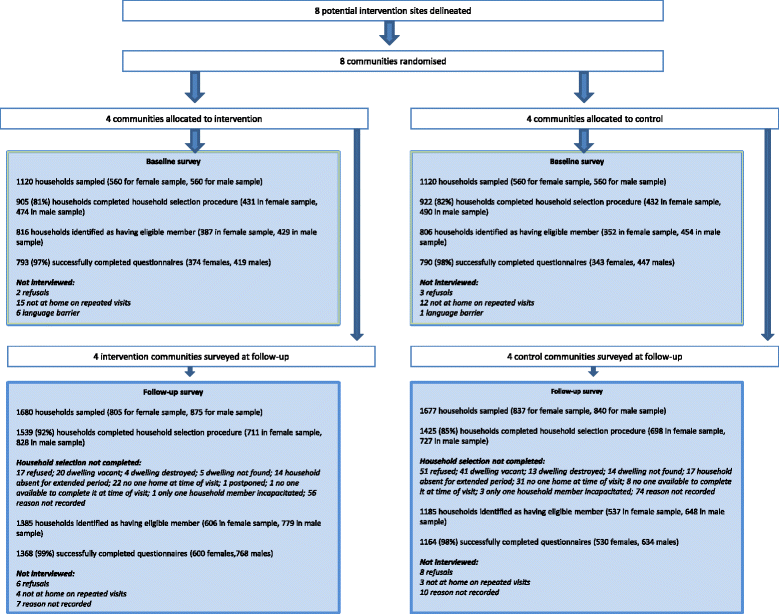Findings from the SASA! Study: a cluster randomized controlled trial to assess the impact of a community mobilization intervention to prevent violence against women and reduce HIV risk in Kampala, Uganda
- PMID: 25248996
- PMCID: PMC4243194
- DOI: 10.1186/s12916-014-0122-5
Findings from the SASA! Study: a cluster randomized controlled trial to assess the impact of a community mobilization intervention to prevent violence against women and reduce HIV risk in Kampala, Uganda
Abstract
Background: Intimate partner violence (IPV) and HIV are important and interconnected public health concerns. While it is recognized that they share common social drivers, there is limited evidence surrounding the potential of community interventions to reduce violence and HIV risk at the community level. The SASA! study assessed the community-level impact of SASA!, a community mobilization intervention to prevent violence and reduce HIV-risk behaviors.
Methods: From 2007 to 2012 a pair-matched cluster randomized controlled trial (CRT) was conducted in eight communities (four intervention and four control) in Kampala, Uganda. Cross-sectional surveys of a random sample of community members, 18- to 49-years old, were undertaken at baseline (n = 1,583) and four years post intervention implementation (n = 2,532). Six violence and HIV-related primary outcomes were defined a priori. An adjusted cluster-level intention-to-treat analysis compared outcomes in intervention and control communities at follow-up.
Results: The intervention was associated with significantly lower social acceptance of IPV among women (adjusted risk ratio 0.54, 95% confidence interval (CI) 0.38 to 0.79) and lower acceptance among men (0.13, 95% CI 0.01 to 1.15); significantly greater acceptance that a woman can refuse sex among women (1.28, 95% CI 1.07 to 1.52) and men (1.31, 95% CI 1.00 to 1.70); 52% lower past year experience of physical IPV among women (0.48, 95% CI 0.16 to 1.39); and lower levels of past year experience of sexual IPV (0.76, 95% CI 0.33 to 1.72). Women experiencing violence in intervention communities were more likely to receive supportive community responses. Reported past year sexual concurrency by men was significantly lower in intervention compared to control communities (0.57, 95% CI 0.36 to 0.91).
Conclusions: This is the first CRT in sub-Saharan Africa to assess the community impact of a mobilization program on the social acceptability of IPV, the past year prevalence of IPV and levels of sexual concurrency. SASA! achieved important community impacts, and is now being delivered in control communities and replicated in 15 countries.
Trial registration: ClinicalTrials.gov #NCT00790959.
Figures
Comment in
-
Preventing and reducing violence against women: innovation in community-level studies.BMC Med. 2014 Oct 1;12:155. doi: 10.1186/s12916-014-0155-9. BMC Med. 2014. PMID: 25286152 Free PMC article.
References
Publication types
MeSH terms
Associated data
LinkOut - more resources
Full Text Sources
Other Literature Sources
Medical
Research Materials
Miscellaneous




